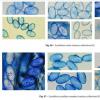
18-06-2025 19:24
 Bernard Declercq
Bernard Declercq
Good evening,On Oenanthe aquatica we collected a

18-06-2025 16:24
 Andgelo Mombert
Andgelo Mombert
Bonjour,Un minuscule stade imparfait, qui pousse s

13-06-2025 16:34
 Andgelo Mombert
Andgelo Mombert
Bonjour,Un petit discomycète qui me résiste. Il

11-06-2025 16:26
Hi everyone, I am looking for the following protol

17-06-2025 12:10
Del pasado dia 4 en bosque de hayas, en tierraA

12-03-2025 17:54
Karl Soler KinnerbäckHi all!Do you agree with Scutellinia hyperborea? P

17-06-2025 12:02
Del pasado sabado, en bosque de hayas y avellanos,

13-06-2025 09:41
Hello.A cerebriform ascomycete sprouting scattered
• S. scutellata group (part 18 in Jeannerot's key): Long hairs, small ellipsoid spores, ornamentation of warts and ridges.
• S crinita rather than S. scutellata complex: Spores with rounded poles, mean Q 1.5 and mostly <= 1.6, often slightly wider than range in Jeannerot's key.
Habitat: On exposed inner bark still attached to dead trunk or woody debris, some erupting from cracks in the bark, wood looks like Fraxinus excelsior, relatively exposed but damp area, near a stream and backwater, mixed deciduous woodland, southern England, mid-March.
Associates: Hyalorbilia cf. inflatula (no micro) and Nectriaceae sp. anamorph on debris, purplish-whitish crust fungus (possibly Peniophora sp.) on the trunk, dematiaceous fungi, bryophytes, some small translucent mites on debris (like those seen with Hyalorbilia inflatula previously).
Apothecia: Gregarious to 4-caespitose, diameter < 5 mm, orange, initially globose and covered by dense eyelash-like hairs, becoming broadly cupulate to cyathiform, more flat when larger, sessile, superficial; dark hairs on margin and flanks, developing early, longer and inwards-pointing at margin, shorter at flanks; receptacle dull yellow-orange, margin distinct, slightly raised; disc +/- plane, deep orange, +/- pruinose (mature asci); no visible subiculum.
Storage and methods: Stored for ~48 hours in a damp box, sections taken from a single large and mature-looking apothecium, mounted in water, little pressure required for squashing, chemicals added to water mount.
Asci: 8-spored, cylindric-clavate, thin-walled, uniseriate, simple or bifurcate base (h-shape observed), after several minutes started discharging in water mount.
• Vital mature: Clavate, apex rounded-obtuse, 1-1.5-seriate, spores more horizontal especially towards the apex, distinctly protruding from paraphyses, pars sporifera ~40%.
• Dead mature: Limited loss of turgidity, cylindrical, apex acute-truncate, sometimes with shoulders/narrowing, sometimes operculum more visible, uniseriate, spores vertical, spores often not in apex and more loosely distributed, pars sporifera ~60-70%.
Spores: Ellipsoid, homopolar-rounded, mean Q 1.5, thick-walled ~1.5-2 um, with perispore, relatively small (for genus), highly guttulate when mature and fresh, small to medium-size greenish LBs ~1.5-2.5 um diameter, OCI 5, apparently LBs increasing with maturity, ornamentation of small warts and crests, protruding in median view < 1 um, (peri)spores attached by gelatinous stringy material in asci and post-discharge, four spores in one ascus appear collapsed and lens-shaped (diameter ~10-12 um), immature spores appear to have large perispore (one measured ~23 x 17 um with spore ~12 x 9 um).
Measurements of vital mature spores in water mount and asci (not including perispore): (16.8) 17.7 - 20.1 (20.8) × (11.1) 11.6 - 13.3 (13.9) µm, Q = (1.4) 1.42 - 1.6 (1.7), N = 49, Me = 18.9 × 12.5 µm, Qe = 1.5.
Paraphyses: Long, narrow, clavate-spatulate apex, multi-septate, reddish contents (VBs?) particularly in apical and basal cells, exceeding immature asci.
Hairs: Long, dark, multiseptated, narrowly to moderately conical, straight to slightly crooked towards the disc, acute apex, some short hairs with rounded apex, base abruptly multi-furcate, often 2-3-furcate, pointing inwards at margin ~1-1.5 mm long, at margin and upper flanks ~0.5-0.7 mm long, at lower flanks ~0.1-0.5 mm long, yellowish-hyaline exudate clinging to some hairs.
Subhymenium: Pale orange due to paraphysis bases, with swollen hyaline cells.
Ectal excipulum: Hyaline, textura globosa-prismatica, large cells; marginal cells smaller, clavate, 2-septate?, with small orangish LBs.
Medullary excipulum: Hyaline, textura porecta?
Basal attachment: Some small hyaline hyphae, not forming subiculum.
KOH + CR: Walls standard reaction.
+ Clemecon's CRB: Perispore faintly blue.

I have no experience, and it does seem difficult to be certain about some of the species in point 18 of the key.
There are some spores with similar looking ornamentation in the photos of S. crinita from the key (included below), although others have smaller, scattered warts. Considering the other characters in the key too then I thought it seemed to fit best.
It would be nice to see more precise descriptions of these species.
Photos from Jeannerot (2019).

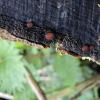
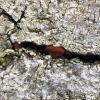
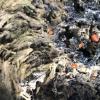
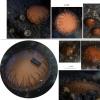

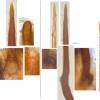

 Hymenium-0006.jpeg
Hymenium-0006.jpeg